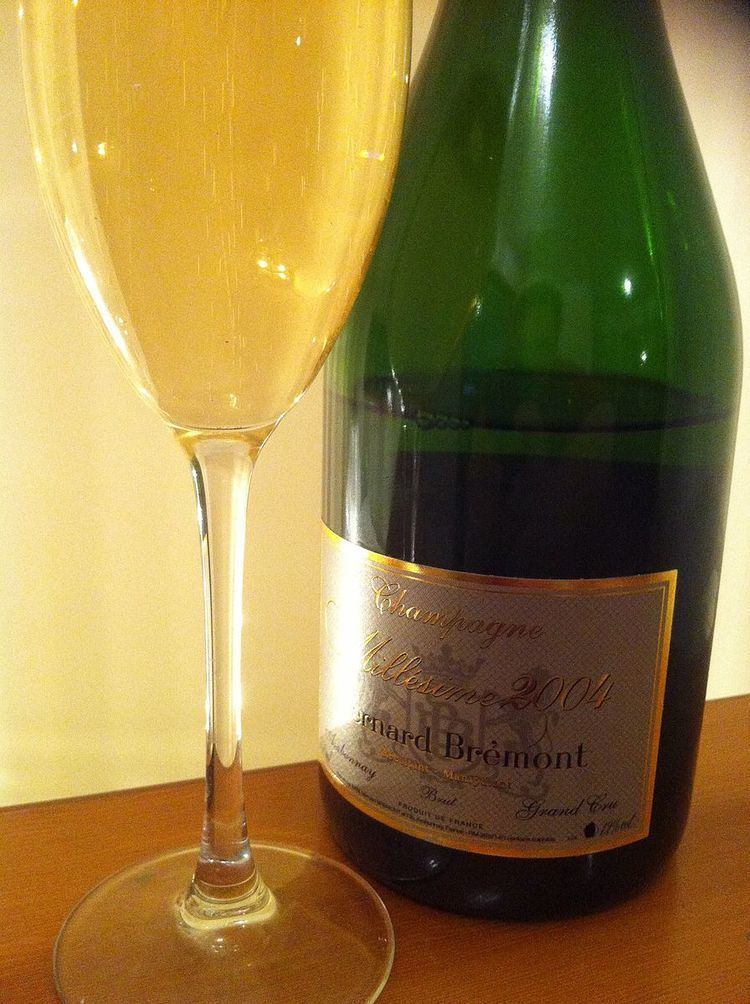 | ||
Grower Champagnes are sparkling wines made in the Champagne region of France that are produced by the same estate that owns the vineyards from which the grapes come. While large Champagne houses, such as Mumm, may use grapes sourced from as many as 80 different vineyards, Grower Champagnes tend to be more terroir-focused, being sourced from a single vineyard or closely located vineyards around a village. Today there are over 19,000 independent growers in the Champagne region, accounting for nearly 88% of all vineyard land in the region. Around 5000 of these growers produce wine from their own grapes. A Grower Champagne can be identified by the initials RM (Récoltant-Manipulant) on the wine label.
Contents
Wine styles
Grower Champagnes have been described as "artisanal winemaking" with terroir being at the forefront for each wine, rather than an emphasis on a consistent "house style" that can be made year after year. While large Champagne houses, such as Moët et Chandon may source grapes from the entire Champagne region, the vineyards owned by a Grower Champagne maker are generally clustered around a single village. Some growers will craft their wine to reflect the terroir of that village, especially if they own vineyards in one of Champagne's Grand crus. Grower Champagnes are often released younger than their large house counterparts due, in part, to the greater financial resources that would be needed for long term aging and storage. Many also show a lower dosage, and occasionally no dosage at all, than most negociant manipulant bottlings.
Sales market
The popularity of Grower Champagne is a relatively recent phenomenon. Since the 18th century, Champagne houses have dominated the business dynamic in the region. These private houses or negociants would buy grapes from the owners of several vineyards to blend and make Champagne. As of 2003, there were over 3,700 brands of Grower Champagnes available for purchase within France but only around 130 brands in the United States. As of 2008, these wines accounted for less than 3% of Champagne market, with that market growing as the wines continue to increase in popularity. Distributors and wine retailers tend to tout the comparative value and lower cost of Grower Champagnes versus the wines of larger Champagne houses, due to the larger Champagne houses' costs of mass market advertising. The smaller Growers leave it up to the importer and wine retailer to market their wines.
Criticisms
A common criticism of Grower Champagnes is the potential for variable quality, especially from vintage to vintage. While the larger Champagne houses and negociants have the flexibility to buy grapes from all over the Champagne region, Grower Champagne makers are limited to only their vineyard holdings. Conversely, advocates of Grower Champagnes say that the blending of many terroirs by the larger houses makes those wines "underflavored" and non-distinctive.
Vineyard lands
There are over 19,000 independent growers in the Champagne region, accounting for nearly 88% of all vineyard land in the region. Around 5000 of these growers produce wine from their own grapes. The larger Champagne houses have holdings in only 12% of the region's vineyards, making it a necessity for them to buy grapes from independent growers. Under current Appellation d'origine contrôlée (AOC) regulations, there are strict limitations on planting. Some growers are seeing an economic advantage in making wine from their own grapes, especially if they have land in one of Champagne's Grand cru villages, rather than selling them to the larger houses where they become part of a generic blend.
Identifying Champagnes
Champagnes can be identified by the initials that appear before a number on the wine label. The initials most commonly associated with Grower Champagnes is RM (meaning Récoltant-Manipulant) but there are other initials that may appear on the label.
Other initials:
